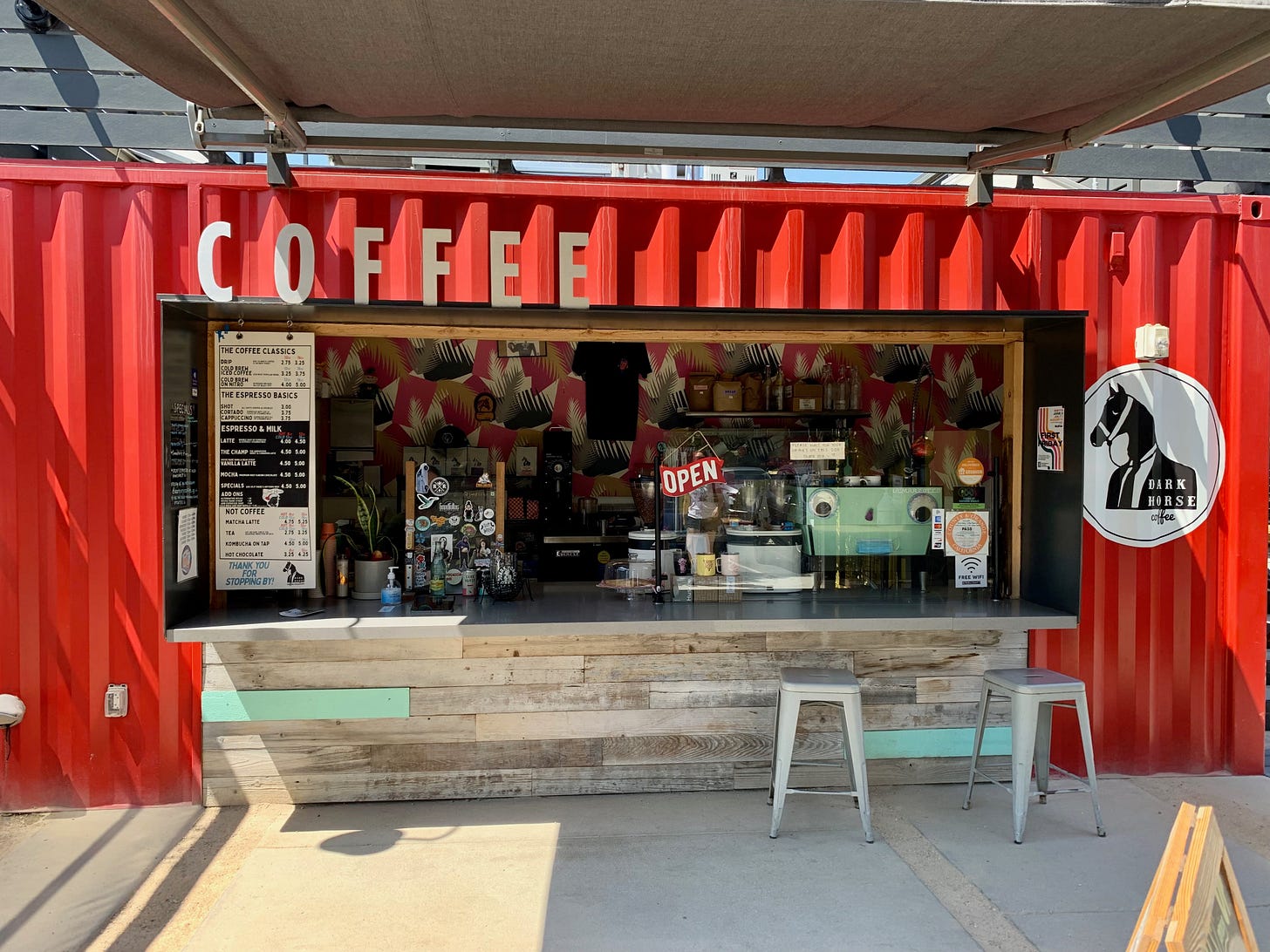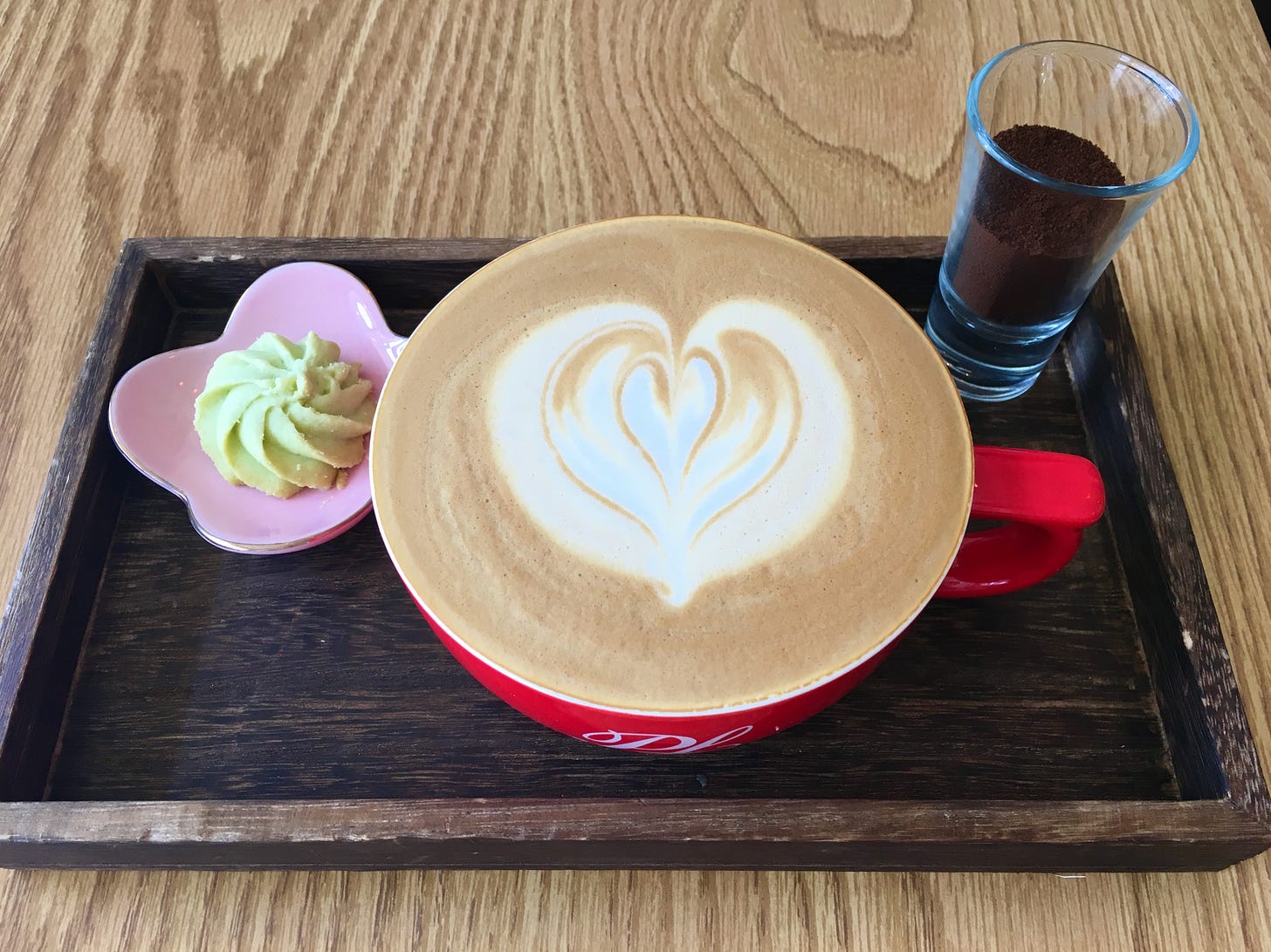Now to things that really matter: coffee…
New York City, NY
I get flak from many on my coffee obsession for a variety of reasons. Some consider it snobbery, pointless extravagance, or a mere addiction. Of course, it is an addiction, and some do worry about starting drinking coffee for fear of becoming addicted, to which I always say, “It’s not a problem if you don’t stop.”
However, I prefer to think of my obsession with coffee as a kind of pursuit of excellence, or what the Greeks called aretê (translated as “excellence,” but which Plato screwed up and morphed into “virtue,” whereas the original notion has no moral dimension, none that is straightforward in the modern sense, at least). The idea was that in the pursuit of excellence you (the subject) become one with the object (coffee, let’s say) in an event or relationship that produces the highest quality (I think Robert Pirsig would agree—just substitute coffee for motorcycle). Often, this quality jumps out at you in the location the coffee is served, which screams care and concern for what the establishment is offering:
Maan Coffee, Chongqing, China
But, of course, such discernment of excellence has to be cultivated. For me, it’s the entire process: the machinery, getting the perfect grind size, the perfect amount of grinds, the perfect espresso pressure, the perfect ratio of beans to extraction, the perfect milk froth, the perfect pour, the perfect flavor, ever so subtle—too subtle for the Starbucks masses to discern because they are accustomed to everything being burned (because, you know, burning coffee standardizes it, annihilating difference, and thus chance, and thus surprise, and thus all novelty and quality with it).
I can taste not just the coffee but the process: whether the coffee cherries were dried before depulping, for how long, and how much so (the difference between washed and honey processes, for instance), how long they were roasted, etc. (to coffee connoisseurs, such things are basic, of course).
I don’t just taste coffee. I taste the earth, the entire ecology, which brings it to life. A Starbucks coffee for me is at least eleven dimensions away from 100% Kona peaberry coffee, let’s say. Let me taste coffees blind, and I’ll tell you every detail just from the flavor and the aroma. The same goes for a good wine, although that’s never been my forte. It’s a “small excellence,” which the Japanese call bonsai—you know, the tiny, cultivated trees or shrubs, or, in this case, tiny, cultivated beans, along with the process that reveals a quality withdrawn from the observer until the fusion of technology and the human spirit reveals their flavorful depths.
Perhaps, for just a moment with just a small thing, perfection is achieved and experienced: the highest quality. Throughout are some photos of my own coffee chronicles over the years, my pursuit of perfection, with a particularly favorite location below:
Avva Coffee, Beverly Hills, CA
So, coffee is an event, a process, and the object is the effect, or response, to the quality of our relationship with the world. The perfect source (Kona, etc.) is just the beginning. It’s everything that comes after that draws out—Heidegger would say reveals or brings to light, which is the essence of technology (from Greek tékhnē, craft or art)—the innate excellence in nature itself (the coffee cherries).
But only a true craftsman with a proper relationship to nature, in a perfect blending of subject and object, can do this. This is the achievement of aretê. And for the rhetorician-philosopher, the desire to achieve aretê in many aspects of life, to be “an excellent all-rounder,” pursuing quality in many areas, is the highest goal (Pirsig).
So, the process is not about “technology” in the modern sense. For Heidegger, it’s about revealing what is already there, an innate potency that technology, as craft, makes visible (or, in this case, tastable). Luckily, here in California, we need not go too far—though we can for quality coffee in every direction—to sample perfection:
Dark Horse Coffee, Anaheim
Dune Coffee Roasters, Santa Barbara, CA
How do you seek out quality coffee? Any place I go I attend to three things before buying (you know, like a five-paragraph essay):
Type of espresso machine (a manual Italian machine is preferred; automatic and I walk away—so we’re talking at least a 20k machine)
Type of beans (not too dark, which burns off both flavor and caffeine)
Speed of coffee-making (if they’re making lattes in less than five minutes I walk away)
La Marzocco GB5 S Commercial Espresso Machine EE (20k)
There are of course other aspects you can attend to, especially the aroma, or other tech being used (type of grinder, etc.), but I wouldn’t want to muddle my perfect five-paragraph essay with additional though excellent points (I have certainly gotten accustomed to the quiet but high pitch sound of a quality grinder though), as my 10th grade English teacher would frown upon this. Of course, back then I only ever had two points per essay, so apparently I’ve graduated to ruining the format in a more complex way… (you’re welcome, Mr. Olson).
Another good way of spotting quality coffee is simply to open your eyes and see what they’re serving. If they only serve in paper cups, bad sign—not as bad as prior to the Covid-19 hysteria, whereby people lost confidence in the ability of soap to kill germs and thereby served primarily in to-go containers, with coffee mugs, and cups and saucers, being pointless victims in the process.
Still, the highest quality coffee roasters have reverted to serving “for here,” which means you’ll enjoy a better flavor—the physics and chemistry of coffee and its container matters. As quantum physicist Wolfgang Pauli writes, “As the alchemists correctly surmised, matter goes just as deep as the spirit.” Then you’ll get coffee that looks like this:
Handlebar Coffee Roasters, Santa Barbara, CA
Miscellaneous Quality Coffee, Diamond Bar, CA
Arcade Coffee Roasters, Riverside, CA
Canabru Coffee, Chino, CA
Augie’s Coffee, Claremont, CA
Roosevelt Coffee, Irvine, CA
Miscellaneous (I Can’t Read Chinese) Shop in Chongqing, China
Dulce, University of Southern California Village, Los Angeles, CA
Ministry of Coffee, University of Southern California, Los Angeles, CA
All this has led to a special preference for 100% Kona peaberry coffee, as I often mention—the best in the world, as far as I’m concerned—but a good pound runs $140, or $90 in Hawaii, so it’s an occasional treat, one I’m enjoying right now, actually, to ease the suffering of returning to “normal” after a three-week China trip (where the coffee scene has grown exponentially, making visualizing a life there easier than it always already was). But it does require a home espresso machine, which I of course have, and knowledge of how to operate it well manually (which I of course have). Now I’ve made the snobbery quite legible…
Hawaiian Kona Peaberry Coffee Cherries (Stock Image)
Not that I started out this way. I started as a Starbucks pleb the same as most people in this depressingly dull land. But little by little, growth is possible. When you absolutely must settle for inferior coffee, a cold brew is harder to screw up and generally yields better results. Ordering a latte at Starbucks is suicidal, or at least masochistic. I did feel like a latte in the airport in Hong Kong, where Starbucks was the only option, and ordered an iced latte against my better judgment for much needed caffeine prior to a thirteen hour flight cultivated in the depths of hell. It was ready in ten seconds flat. I almost had an aneurysm…
To develop your tastes, buy your own quality beans and do it yourself with some attention and practice. Even better, let other people buy quality beans for you. Below are some beans students have given me. In fact, I once had a student whose mom was a coffee roaster (two roasts pictured below). Student, if you are reading this, I’m always available to sample more roasts, free of charge:
If you follow the above rules and guidelines, however, a window into the heavens will open, whereby—just for a moment—you will glimpse perfection in the harmonious unity, Heidegger might say, of earth, sky, divinities, and mortals, all made present in the perfect shot of espresso, for which one should rightly do the work (or wait five minutes for someone else to do it). God forbid we wait five minutes for a taste of perfection. Most prefer ten seconds for a taste of the dregs of depravity only humanity incessantly unearths.
So, you know… that’s why I like coffee and stuff…




















